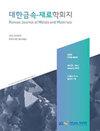Effects of Stacking Number on Microstructure and Mechanical Properties for Cold Roll Bonding Process of Dissimilar Aluminum Alloy Sheets
IF 1.1
4区 材料科学
Q4 MATERIALS SCIENCE, MULTIDISCIPLINARY
引用次数: 0
Abstract
A cold roll-bonding (CRB) process is applied to study the effects of stacking number on the microstructure and mechanical properties of roll-bonded and age-treated Al sheets. Commercial AA1050 and AA6061 sheets with a thickness of 2 mm were stacked alternately on each other to two and four layers, and roll-bonded by multi-pass cold rolling. The roll-bonded Al sheets were then subjected to natural aging (T4) and artificial aging (T6) treatments. The as roll-bonded Al sheets showed a typical deformation structure, where the grains are elongated in the rolling direction regardless of the stacking number. However, after the T4 and T6 aging treatments, the Al sheets had a recrystallization structure consisting of coarse grains in both the AA5052 and AA6061 regions with different grain sizes in each. In addition, the sheets showed an inhomogeneous hardness distribution in the thickness direction, with higher hardness in AA6061 than in AA1050 after the T4 and T6 age treatments. The tensile strength of the T6-treated specimen was higher than that of the T4-treated one for both the 2 and 4-layer CRBs. In addition, both the tensile strength and elongation of the specimens processed by the 4-layer stack CRB were higher than those of the 2-layer stack CRB for all experimental conditions.堆积次数对异种铝合金板冷滚焊组织和力学性能的影响
采用冷滚焊(CRB)工艺研究了层数对滚焊和时效处理铝片组织和力学性能的影响。将厚度为2mm的市售AA1050和AA6061片材交替堆叠成两层和四层,并通过多道次冷轧进行辊结合。然后对辊结合的Al片进行自然老化(T4)和人工老化(T6)处理。轧制态结合的Al片表现出典型的变形结构,其中晶粒在轧制方向上伸长,而与堆叠数量无关。然而,在T4和T6时效处理之后,Al片具有由AA5052和AA6061区域中的粗晶粒组成的再结晶结构,每个区域中具有不同的晶粒尺寸。此外,片材在厚度方向上显示出不均匀的硬度分布,在T4和T6时效处理后,AA6061中的硬度高于AA1050中的硬度。对于2层和4层CRB,T6处理的试样的抗拉强度都高于T4处理的试样。此外,在所有实验条件下,由4层堆叠CRB处理的试样的拉伸强度和伸长率都高于2层堆叠CRB。
本文章由计算机程序翻译,如有差异,请以英文原文为准。
求助全文
约1分钟内获得全文
求助全文
来源期刊

Korean Journal of Metals and Materials
MATERIALS SCIENCE, MULTIDISCIPLINARY-METALLURGY & METALLURGICAL ENGINEERING
CiteScore
1.80
自引率
58.30%
发文量
100
审稿时长
4-8 weeks
期刊介绍:
The Korean Journal of Metals and Materials is a representative Korean-language journal of the Korean Institute of Metals and Materials (KIM); it publishes domestic and foreign academic papers related to metals and materials, in abroad range of fields from metals and materials to nano-materials, biomaterials, functional materials, energy materials, and new materials, and its official ISO designation is Korean J. Met. Mater.
 求助内容:
求助内容: 应助结果提醒方式:
应助结果提醒方式:


